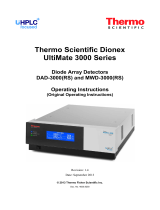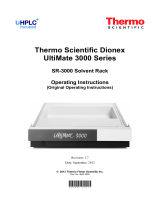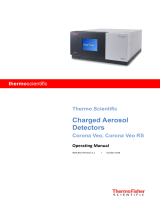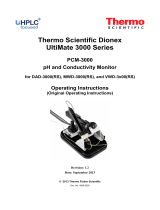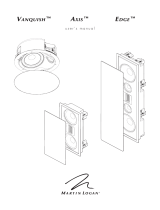La page est en cours de chargement...

Vanquish
HPLC & UHPLC
Systems
Pre-installation Requirements Guide
Revision 3.0 • September 2021
thermoscientific

Copyright © 2021 Thermo Fisher Scientific Inc. All rights reserved.
Trademarks
The following are registered trademarks in the United States and other countries:
Dranetz is a registered trademark of Dranetz Technologies Inc. ionBench is a trademark of
ionBench Corporation. PEEK is a trademark of Victrex PLC. Styrofoam is a registered trademark
of Dow Chemical Company. All other trademarks are property of Thermo Fisher Scientific and its
subsidiaries.
Thermo Fisher Scientific Inc. provides this document to its customers accompanying a product
purchase to use with the product operation. This document is copyright protected; any
reproduction of the whole or any part of this document is strictly prohibited except with the
written authorization of Thermo Fisher Scientific Inc.
This manual is provided "as is." The contents of this manual is, without notice, subject to change
for future revisions.
Thermo Fisher Scientific Inc. makes no representations that this document is complete,
accurate, or error-free. Thermo Fisher Scientific Inc. assumes no responsibility and will not be
liable for any errors, omissions, damage, or loss that might result from any use of this document
even if the information in the document is followed properly.
This document is not part of any sales contract between Thermo Fisher Scientific Inc. and a
purchaser. This document shall in no way govern or modify any Terms and Conditions of Sale.
The Terms and Conditions of Sale shall govern all conflicting information between the two
documents.
Release history
Revision 3.0, released in September 2021, addition of the Vanquish™ Core HPLC System and
Vanquish Neo UHPLC System
Revision 2.0, released in June 2018, addition of the Vanquish Duo (U)HPLC System
Revision 1.0, released in February 2017, initial version for Vanquish Horizon and Vanquish Flex
UHPLC Systems

Contacting Us
Vanquish Manual - Template Operating Manual Page 3
Contacting Us
There are several ways to contact us:
Ordering Information
For ordering information or sales support for HPLC products, contact
your local Thermo Fisher Scientific sales organization. For contact
information, go to Contact Us on http://www.thermofisher.com.
Technical Assistance
For technical support for HPLC products, contact your local Thermo
Fisher Scientific support organization. For contact information, go to
Contact Us on http://www.thermofisher.com.

Contents
Page 4 Vanquish Manual - Template Operating Manual
Contents
1 Using this Manual ............................................................................. 7
1.1 About this Manual...................................................................................................8
1.2 Conventions ............................................................................................................9
1.2.1 Safety Messages .........................................................................................9
1.2.2 Special Notices and Informational Notes ...................................................9
1.2.3 Typographical Conventions ..................................................................... 10
1.3 Reference Documentation ................................................................................... 11
2 Safety ............................................................................................. 12
2.1 Safety Symbols and Signal Words ........................................................................ 13
2.1.1 Safety Symbols and Signal Words in This Manual ................................... 13
2.1.2 Observing this Manual ............................................................................ 14
2.1.3 Safety Symbols on the System and in this document ............................. 14
2.2 Intended Use ........................................................................................................ 16
2.3 Safety Precautions ............................................................................................... 17
2.3.1 General Safety Information ..................................................................... 17
2.3.2 Consignes Générales de Sécurité ............................................................ 19
2.4 Federal Communications Commission (FCC) Note .............................................. 22
2.5 Compliance Information ...................................................................................... 23
3 Site Preparation .............................................................................. 25
3.1 Shipping Containers ............................................................................................. 26
3.2 Space and Load Requirements ............................................................................. 28
3.3 Telephone ............................................................................................................ 37
4 Operation Environment .................................................................. 38
4.1 Temperature ........................................................................................................ 39
4.2 Humidity ............................................................................................................... 41
4.3 Vibration .............................................................................................................. 41
4.4 Lighting ................................................................................................................. 41
4.5 Particulate Matter ................................................................................................ 41
4.6 Electrostatic Discharge ......................................................................................... 42
4.7 Gas Supply ............................................................................................................ 44

Contents
Vanquish Manual - Template Operating Manual Page 5
5 Line Power ......................................................................................45
5.1 Quality of Power ................................................................................................... 46
5.2 Power Monitoring Devices.................................................................................... 47
5.3 Power Conditioning Devices ................................................................................. 48
5.4 Available Outlets ................................................................................................... 49
5.5 Connecting to Power Sockets ............................................................................... 52
5.6 Uninterruptible Power Supply .............................................................................. 55
5.7 Technical Assistance ............................................................................................. 55
6 Waste and Ventilation ....................................................................56
6.1 General.................................................................................................................. 57
6.2 Vanquish Charged Aerosol Detectors ................................................................... 59
6.2.1 Ventilation Requirements ........................................................................ 59
6.2.2 Drain Connections .................................................................................... 59
7 Solvents ..........................................................................................60
8 Installation ......................................................................................62
8.1 Installation Kits ..................................................................................................... 63
8.2 Installation ............................................................................................................ 64
8.3 Preventive Maintenance ....................................................................................... 65
9 Instrument Shipments .....................................................................66
10 Index .............................................................................................69

Contents
Page 6 Vanquish Manual - Template Operating Manual

1 • Using this Manual
Vanquish Manual - Template Operating Manual Page 7
1 Using this Manual
This chapter provides information about this manual, the conventions used
throughout the manual, and the reference documentation that is available
in addition to this manual.

1 • Using this Manual
Page 8 Vanquish Manual - Template Operating Manual
1.1 About this Manual
NOTICE This Vanquish (U)HPLC System Pre-installation Requirements
Guide document contains information specific to stand-alone Vanquish
(U)HPLC Systems. A typical stand-alone system consists of a Vanquish
system base with solvent rack, a pump, an autosampler, a column
compartment, and a detector.
The Vanquish (U)HPLC Systems are designed to operate reliably under
controlled environmental conditions. As the purchaser, you are
responsible for providing a suitable location, a suitable operating
environment, a source of power of acceptable quality, correct solvent
supplies, and proper waste systems.
Operating a Vanquish (U)HPLC System or maintaining it in a condition
outside the power and operating environment specifications described
in this guide might cause failures of many types. The repair of such
failures is specifically excluded from the standard warranty and service
contract coverage.
This Vanquish HPLC & UHPLC Systems Pre-installation Requirements
Guide is designed to provide you with information to plan and prepare
your lab site prior to delivery and installation of your system. Please
read each chapter carefully to be sure that your laboratory is ready for
the installation of your system.
This Pre-installation Requirements Guide includes information about the
Vanquish System Base with Solvent Rack, Vanquish Pumps, Vanquish
Autosamplers, Vanquish Column Compartments, the Vanquish
Detectors, including specific information about the Vanquish Charged
Aerosol Detector, and the Vanquish Neo UHPLC System.
The Vanquish modules are controlled by a chromatography data system.
The data system hardware consists of a desktop computer, a monitor,
and an optional printer.
NOTICE If you are integrating your Vanquish (U)HPLC System with a
Thermo Scientific mass spectrometer, please also refer to the Pre-
installation Requirements Guide of the mass spectrometer.

1 • Using this Manual
Vanquish Manual - Template Operating Manual Page 9
1.2 Conventions
This section describes the conventions that are used throughout this
manual.
1.2.1 Safety Messages
The safety messages and precautionary statements in this manual
appear as follows:
• Safety messages or precautionary statements that apply to the
entire manual and all procedures in this manual are grouped in the
Safety chapter.
• Safety messages or precautionary statements that apply to an entire
section or to multiple procedures in a section appear at the
beginning of the section to which they apply.
• Safety messages that apply to only a particular section or procedure
appear in the section or procedure to which they apply. They appear
different from the main flow of text.
Safety messages are often preceded by an alert symbol and/or alert
word. The alert word appears in uppercase letters and in bold type.
Make sure that you understand and follow all safety messages
presented in this manual.
1.2.2 Special Notices and Informational Notes
Special notices and informational notes in this manual appear different
from the main flow of text. They appear in boxes and a note label
identifies them. The label text appears in uppercase letters and in bold
type.
NOTICE Highlights information necessary to prevent damage to the
system or invalid test results.
TIP Highlights information of general interest or helpful information that
can make a task easier or optimize the performance of the system.

1 • Using this Manual
Page 10 Vanquish Manual - Template Operating Manual
1.2.3 Typographical Conventions
These typographical conventions apply to the descriptions in this
manual:
Data Input and Output
• The following appears in bold type:
♦ Input that you enter via keyboard or select with the mouse
♦ Buttons that you click on the screen
♦ Commands that you enter by the keyboard
♦ Names of, for example, dialog boxes, properties, and parameters
• For brevity, long expressions and paths appear in the condensed
form. For example: Click Start > All Programs > Thermo
Chromeleon 7 > Services Manager > Start Instrument Controller.
References and Messages
• References to additional documentation appear italicized.
• Messages that appear on the screen are identified by quotation
marks.
Viewpoint
If not otherwise stated, the expressions left and right in this manual
always refer to the viewpoint of a person that is facing the (U)HPLC
system from the front.
Particularly Important Words
Particularly important words in the main flow of text appear italicized.
Electronic Manual Version (PDF)
The electronic version (PDF) of the manual contains numerous links that
you can click to go to other locations within the manual. These include:
• Table of contents entries
• Index entries
• Cross-references (in blue text), for example, to sections and figures

1 • Using this Manual
Vanquish Manual - Template Operating Manual Page 11
1.3 Reference Documentation
In addition to this guide, Thermo Fisher Scientific provides the following
documents as PDF files or printed booklets for the Vanquish (U)HPLC
Systems:
• Thermo Scientific Vanquish UHPLC System Operating Manual
• Thermo Scientific Vanquish Neo (VN-A10, VN-C10, VN-P10, VN-S10)
Operating Manual
• Thermo Scientific Pumps C, Pumps F (VC-Pxx, VF-Pxx) Operating
Manual
• Thermo Scientific Vanquish Binary Pump H (VH-P10-A[-02])
Operating Manual
• Thermo Scientific Vanquish Split Samplers (VH-A10, VF-A10, VH-A40,
VF-A40, VC-A12/13) Operating Manual
• Thermo Scientific Vanquish Charger (VH-A90-A) Operating Manual
• Thermo Scientific Vanquish Column Compartments (VH-C10, VC-C10)
Operating Manual
• Thermo Scientific Vanquish Diode Array Detector HL (VH-D10-A)
Operating Manual
• Thermo Scientific Vanquish Diode Array Detectors and Multi-
Wavelength Detector (VC-D11, VC-D12, VF-D11) Operating Manual
• Thermo Scientific Vanquish Variable Wavelength Detectors (VF-D40,
VC-D40) Operating Manual
• Thermo Scientific Vanquish Fluorescence Detectors (VC-D50, VC-D51,
VF-D50, VF-D51) Operating Manual
• Thermo Scientific Vanquish Charged Aerosol Detectors (VH-D20, VF-
D20) Operating Manual
TIP Electronic versions of these manuals are available as PDF (Portable
Document Format) files. To open and read the PDF files, AdobeTM
ReaderTM or AdobeTM AcrobatTM is required.

2 • Safety
Page 12 Vanquish Manual - Template Operating Manual
2 Safety
This chapter provides general and specific safety information and informs
on the intended use of the system.

2 • Safety
Vanquish Manual - Template Operating Manual Page 13
2.1 Safety Symbols and Signal Words
2.1.1 Safety Symbols and Signal Words in This Manual
This manual contains safety messages to prevent injury of the persons
using the system. The safety symbols and signal words in this manual
include the following:
Always be aware of the safety information. Do not proceed until you
have fully understood the information and consider the consequences of
what you are doing.
IMPORTANT Indicates that failure to take note of the accompanying
information could cause erroneous results or may result in damage to
the instrument.
IMPORTANT Indique que ne pas tenir compte de l'information jointe
peut conduire aux résultats faux ou endommager l'instrument.
CAUTION High voltage, risk of electrical shock.
Attention Haute tension, risque de choc électrique.
WARNING Indicates that failure to take note of the accompanying
information may result in personal injury.
AVERTISSEMENT Indique que ne pas tenir compte de l'information
jointe peut entraîner des blessures corporelles.

2 • Safety
Page 14 Vanquish Manual - Template Operating Manual
2.1.2 Observing this Manual
Observe the following:
• Before installing or operating the system, read this manual carefully
to be familiar with the system and this manual. The manual contains
important information regarding user safety as well as use and care
of the system.
• Always keep the manual near the system for quick reference.
• Save this manual and pass it on to any subsequent user.
Read, understand, and comply with all safety messages and
precautionary statements presented in this manual.
2.1.3 Safety Symbols on the System and in this document
The table shows the symbols used on the Vanquish modules and/or in
this Pre-installation Requirements Guide:
Symbol Description
Indicates a power button that switches the system between on and off
states.—Indique un bouton d’alimentation électrique qui permet de
mettre sous tension ou hors tension le système.
Electrical power is on (−)—L'instrument est mis sous tension (−) and
Electrical power is off (O)—L'instrument est mis hors tension (O)
Alternating current—Courant alternatif
Direct current—Courant continu
Protective conductor terminal, ground—Conducteur de protection
Fuse—Fusible
High voltage, risk of electrical shock—Haute tension, risque de choc
électrique
Component susceptible to electrostatic discharge—Le composant est
susceptible de la décharge électrostatique
˜

2 • Safety
Vanquish Manual - Template Operating Manual Page 15
Symbol Description
Surface becomes hot during operation—La surface devient chaude
lors du fonctionnement.
Puncture hazard—To avoid injury during autosampler operation, keep
your hands away from the syringe.
Risque de pincement—Pour éviter des blessures pendant l'opération
du passeur d'échantillon, tenez vos mains à distance de la seringue.
Pinch point hazard—Risque de pincement
Refer to the Operating Manual to prevent risk of harm to the
operator and to protect the instrument against damage.
Référez-vous à ce manuel pour éviter tout risque de blessure à
l'opérateur et/ou protéger l'instrument contre tout dommage.
The deuterium lamp emits UV radiation that is harmful to the eyes
and skin. Therefore, avoid looking directly into the light source.
Operate the lamp only in the detector with the lamp cover installed
and never outside the instrument.
Label according to the "Measures for Administration of the Pollution
Control of Electronic Information Products" (China RoHS) guideline
Étiquette "Measures for Administration of the Pollution Control of
Electronic Information Products" (China RoHS)
WEEE (Waste Electrical and Electronic Equipment) label—For more
information, see the WEEE Information section in the "Installation and
Qualification Documents for Chromatography Instruments" binder.
Étiquette DEEE (Déchets d'Equipements Electriques et
Electroniques)—Pour plus d'informations, référez-vous au chapitre
WEEE Information dans le classeur "Installation and Qualification
Documents for Chromatography Instruments".

2 • Safety
Page 16 Vanquish Manual - Template Operating Manual
2.2 Intended Use
The devices are designed to be operated only by qualified and
authorized personnel. All users must know the hazards presented by the
device and the used substances.
The Vanquish (U)HPLC systems are designed for laboratory research use
only in ultra-high-performance liquid chromatography ((U)HPLC)
applications. A PC with multiple USB 2.0 ports (minimum 2) is required.
The Vanquish (U)HPLC systems can be controlled by the Chromeleon
Chromatography Management System. The Vanquish (U)HPLC systems
can also be operated with other data systems. For more information,
contact the Thermo Fisher Scientific sales organization.
If there is any question regarding appropriate usage, contact Thermo
Fisher Scientific before proceeding.
WARNING If the devices are used in a manner not specified by Thermo
Fisher Scientific, the protection provided by the respective device could
be impaired.
Thermo Fisher Scientific assumes no responsibility and will not be liable
for operator injury and/or instrument damage.
Whenever it is likely that the protection is impaired, the instrument must
be disconnected from all power sources and be secured against any
intended operation.
Avertissement Si l'instrument est utilisé de façon non spécifiée par
Thermo Fisher Scientific, la protection prévue par l'instrument pourrait
être altérée.
Thermo Fisher Scientific n'assume aucune responsabilité et ne sera pas
responsable des blessures de l'opérateur et/ou des dommages de
l'instrument.
Si la protection de l'instrument n'est pas garantie à tout moment,
débranchez l'instrument de toutes les sources d'alimentation électrique
et assurez-vous que l'instrument n'est pas utilisé involontairement.

2 • Safety
Vanquish Manual - Template Operating Manual Page 17
2.3 Safety Precautions
2.3.1 General Safety Information
When working with analytical instrumentation, you should know the
potential hazards of using chemical solvents.
TIP Before initial operation of the instruments, make sure that you are
familiar with the contents of this Pre-installation Requirements Guide
and the Operating Manuals of the respective module.
Observe any warning labels on the device and refer to the related
sections in the respective Operating Manuals.
For the general safety precautions in French, see page 22.
To avoid the possibility of personal injury or damage to the instrument,
observe the following general safety precautions when operating the
instrument or performing maintenance and repair procedures:
• Install the HPLC system in a well-ventilated laboratory (see page 38).
If the mobile phase includes volatile or flammable solvents, do not
allow them to enter the workspace.
• All instruments should be on the same ground.
• The modules/systems are too heavy and/or bulky for one person
alone to handle safely. Therefore, a team effort is required to lift or
move the modules/systems.
• When connecting the capillaries, make sure that the connectors are
free from contaminants. Even minute particles may cause damage to
the system (for example, the column).
• If the mobile phase includes volatile or flammable solvents, avoid
open flames and sparks.
• Always replace blown fuses with the fuses recommend by Thermo
Fisher Scientific.
• Replace faulty power cords and communication cables.
• Many organic solvents and buffers are toxic. Know the toxicological
properties of all chemicals that you are using.

2 • Safety
Page 18 Vanquish Manual - Template Operating Manual
• The toxicological properties of many samples may not be well
known. If you have any doubt about a sample, treat it as if it
contains a potentially harmful substance.
• Wear goggles when handling mobile phases or operating the
instrument. An eyewash facility and a sink should be close to the
unit. If any mobile phase splashes on the eyes or skin, wash the
affected area and seek medical attention.
• Dispose of waste mobile phase in an environmentally safe manner
that is consistent with all local regulations. Do not allow flammable
or toxic solvents to accumulate. Follow a regulated, approved waste
disposal program. Never dispose of flammable or toxic solvents
through the municipal sewage system.
• We recommend the use of HPLC- or LC/MS-grade solvents and
additives only.
• Use only reagents and buffers that are compatible with all parts that
may be exposed to solvents. For information about the materials in
the flow path, refer to the Physical Specifications section in the
respective Operating Instruction of the Vanquish system module.
• In the Vanquish (U)HPLC system, capillaries made of PEEK may be
used. Swelling or attack by acids can cause PEEK capillaries to start
to leak or burst. Certain chemicals, for example, trichloromethane
(CHCl3), dimethyl sulfoxide (DMSO), or tetrahydrofuran (THF) can
cause PEEK to swell. Concentrated acids, such as sulfuric acid and
nitric acid, or a mixture of hexane, ethyl acetate, and methanol, can
attack PEEK. Swelling or attack is not a problem with brief flushing
procedures. For more information, refer to the technical literature
on the chemical resistance of PEEK. Note also that the Vanquish
(U)HPLC Systems are designed for reversed-phase (RP) operation
only.
• The fluidics of some Vanquish modules and accessories are designed
as Viper-only. Use only the Viper finger-tight fitting system for fluidic
connections with them. The use of any non-Viper fitting system in
such case will lead to leakages and risk of mechanical damage to
receiving ports.
• Use only the spare parts and accessories recommended in the
Operating Manual of the respective instrument. Substituting parts
may impair the performance of the instrument.
• Do not use the instruments in ways other than those described in
the respective Operating Manuals.

2 • Safety
Vanquish Manual - Template Operating Manual Page 19
2.3.2 Consignes Générales de Sécurité
Veuillez noter Avant de commencer à utiliser l'instrument, assurez-vous
que vous vous êtes familiarisés avec le contenu de ce manuel.
Observez des étiquettes d'avertissement sur l'appareil et référez-vous
aux sections correspondantes dans ce mode d'emploi.
Lors de l’utilisation des instruments analytiques, il faut connaître les
dangers potentiels liés aux solvents chimiques.
Veuillez observer les consignes générales de sécurité suivantes lorsque
vous utilisez l'instrument ou que vous procédez à des opérations de
maintenance afin d’éviter tous risques de préjudice corporel et de
détérioration de l’instrument:
• Installez le système HPLC dans un laboratoire bien ventilé. Si la
phase mobile contient des solvants volatils ou inflammables,
empêchez qu'ils ne pénètrent dans l'espace de travail.
• Tous les instruments du système devraient être reliés au même
système de mise à la terre.
• Le système est trop lourd et/ou encombrant pour être soulever ou
déplacer par une personne seule. Par conséquent, un effort d'équipe
est exigé pour soulever ou déplacer l'instrument.
• Lorsque vous connectez les capillaires, assurez-vous que les raccords
sont exempts de tout contaminant. Même d'infimes particules
peuvent causer des dommages au système (par exemple, la
colonne).
• Si la phase mobile contient des solvants volatils ou inflammables,
évitez les flammes nues et les sources d’étincelles à proximité.
• Si une fuite survient, arrêtez l'instrument et résolvez le problème
immédiatement.
• Remplacez toujours les fusibles grillés par des fusibles de rechange
recommandés par Thermo Fisher Scientific en ce manuel.
• Remplacez les cordons d'alimentation électrique et les câbles de
communication défectueux.

2 • Safety
Page 20 Vanquish Manual - Template Operating Manual
• De nombreux solvants organiques et solutions salines sont toxiques.
Informez-vous des propriétés toxicologiques de toutes les phases
mobiles que vous utilisez.
• Les propriétés toxicologiques de nombreux échantillons peuvent
être mal connues. Au moindre doute concernant un échantillon,
traitez-le comme s'il contenait une substance potentiellement
dangereuse.
• Portez des lunettes de protection lorsque vous manipulez des
phases mobiles ou que vous utilisez l'instrument. Une installation
permettant de se laver les yeux ainsi qu'un lavabo doivent se trouver
à proximité du système. Si une phase mobile, quelle qu'elle soit,
entre en contact avec vos yeux ou votre peau, rincez abondamment
la zone affectée à l’eau, puis consultez un médecin.
• Débarrassez-vous de tous les déchets de phase mobile de manière
écologique, conformément à la règlementation en vigueur au niveau
local. Empêchez impérativement l'accumulation de solvants
inflammables et/ou toxiques. Suivez un programme d'élimination
des déchets règlementé et approuvé. Ne jetez jamais de solvants
inflammables et/ou toxiques dans le système municipal d'évacuation
des eaux usées.
• Utilisez uniquement des solvants et réactifs qualité HPLC ou LC/MS.
• Assurez-vous que les solutions tampons et réactifs sont compatibles
avec les matériaux exposés et les. Pour des informations sur les
matériaux exposés, référez-vous à la section technique en ce manuel
de l’instrument.
• Dans le système Vanquish (U)HPLC, des capillaires en PEEK peuvent
être utilisés. Le gonflement ou l’attaque provoqué par les acides
peut entraîner des fuites ou des brisements des capillaires en PEEK.
Certaines substances chimiques comme le trichlorométhane (CHCl3),
le diméthyle sulfoxide, ou le tétrahydrofurane ont pour effet de faire
gonfler le PEEK. Des acides concentrés tels que l'acide sulfurique et
l'acide nitrique ou un mélange hexane, éthyle acétate et méthanol
peuvent attaquer le PEEK. L’exposition brève dans le cadre de
procédures de nettoyage n’entraîne pas le gonflement ou l’attaque
du matériel en PEEK. Pour obtenir plus d’informations, consultez la
littérature technique sur la résistance chimique du PEEK. Veuillez
noter également que les systèmes Vanquish UPLC sont conçus
uniquement pour la chromatographie en phase inversée.
/
